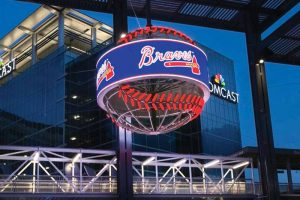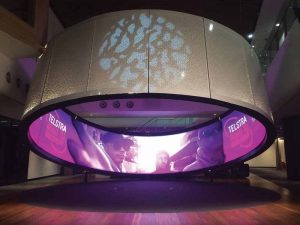Alignment precision

The surrounding metalwork suspending the display’s halo shape makes the entire installation resemble a baseball.
The free-form frame-skin design methodology of truly curved LED displays allows for the management of runout, which is the systematic buildup of gaps, overlaps, and misalignments that occur between adjacent modules as one builds a display. The eye is sensitive enough to perceive these inconsistencies even if they are small, but frame-skin topology allows manufacturers to hit a tolerance ratio of five per cent across a display. This means, the flexible modules align so accurately that their margin of error is a distance measuring only five per cent of pixel pitch—a small ratio faceted curves cannot match. Though a faceted curve can hit low tolerance ratios during its installation, the display imagery will degrade with each calibration over time. Working with facets makes it more difficult to achieve this engineering precision as there are more moving parts.
The gaps between facets can create a range of problems when used outdoors. When displays are subjected to inclement weather conditions, the durability of the technology becomes just as important as its performance and price. With this in mind, many professional sports teams have opted for curved, cylindrical displays to enhance their outdoor fan engagement arenas instead of faceted substitutes. Additionally, curved displays can withstand high wind speeds, deflect gusts, and exclude debris better than most faceted solutions. Pairing this technology with fan experience has been successful in delivering content to multiple outdoor spaces that were previously underutilized.
One baseball franchise, for example, made a similar choice when installing a cylindrical display outside their stadium. Although the curved display is not affected by intense weather conditions, it is located at the intersection of two fairly narrow pedestrian corridors through which wind cycles in several directions. What is interesting about the display is the surrounding metalwork suspending its halo shape, which makes the entire installation resemble a baseball. Though the display is cylindrical, its curved nature completes the spherical effect of the overall installation better than a faceted solution.
Variables
The more variables in a visualization solution, the more likely it is for something to go awry. While flexible LED boards can wrap around their frame in one smooth curve, rigid boards cannot. Thus, seams between adjacent boards aligned at slightly different angles cannot be avoided. This issue is often remedied with a third-party mount, which can cause further complications, both mechanically and optically. These mounts tend to intensify bright or dark lines while rendering the display more difficult to manage over time. Third-party mounts can also increase the time and cost of an installation and complicate logistics throughout the project.
Let content do the talking

A massive LED ring installed in a corporate lobby would not have the same impact on its audiences if it were faceted.
One final difference between faceted displays and true curves relates to their off-axis viewability, which governs the range of angles from which an audience can see the content. To be effective, the content should be seen. That said, the better the off-axis ability of the display, the longer the content will be seen, and the more likely it will be to influence the audience. Truly curved displays have a wider range of off-axis viewability, a crucial advantage against faceted substitutes, considering LED displays are often watched by audiences on the move. Simply grabbing attention is not sufficient; a display must be able to retain it. If an audience looks at an LED feature and, as they move, their viewability is met with poor off-axis image quality resulting from facets, they will lose focus on the actual content and instead concentrate only on the display flaws.
A display manufacturer is successful when audiences are immersed in the overall visual experience and not the display itself. This means, there should be no facets, visible seams between modules, ugly module edges, harsh angles between adjacent modules, misalignments, or colour shifts between modules. Seamless curves deliver what most audiences want—an experience with no interruptions.
Joe‘ Lloyd is vice-president of NanoLumens’ global marketing and business development and recent recipient of the Technology Association of Georgia’s Marketing Executive of the Year award. She is a sought-after speaker, outspoken proponent of social selling, networking, and public relations, and is dedicated to providing marketing with a strong, dependable return on investment (ROI). For more information, contact her via e-mail at jlloyd@nanolumens.com.





